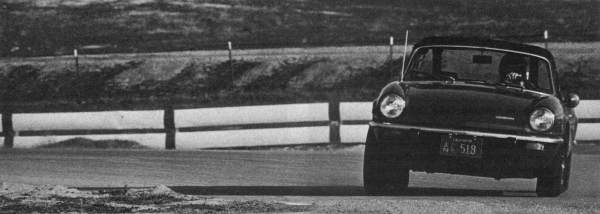April 1973 Road and Track

Back to Basics
Track testing
nine Showroom Stock Sports Cars, the entire
field
in SCCA newest class. Not a fair group, exactly,
but certainly sporting.
|
THIS COMPARISON
TEST is not the
ordinary sort of comparison
test. In the normal course of events the staff selects a group of
comparable
cars—economy sedans, say, or sporting GTs on the basis of roughly equal
size,
price and intent. We put them through a standard series of tests and
vote on
which car performs normal transportation and entertainment functions
best. |
any DOT-approved brand but in the
diameter that fits the
stock wheels be they 13-, 14-, or 15-inch. Having created the class,
the SCCA
filled it with a selection of models, which must be either 1972 or 1973
model
year. The eligible cars are: Fiat 124 Sport Spider; MGB; MGB-GT; MG
Midget;
Opel GT 1900; VW-Porsche9l4 1.7; Triumph GT6; Triumph Spitfire 1500,
and VW
Karmann Ghia. |
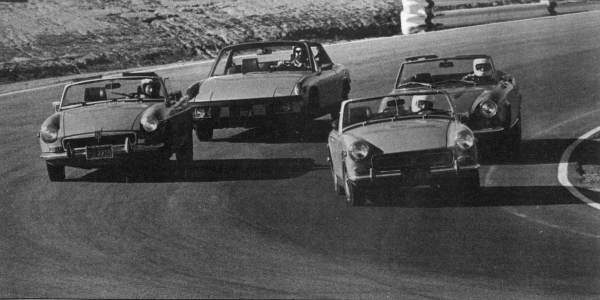
|
To say that a modern, expensive
sports car with a large engine can outrace an older, cheaper sports car
with a smaller engine wouldn’t require tests anyway. The
Tests BECAUSE THE cars in the group were
picked by the SCCA to be
raced against each other, the tests involved here are strictly for
track purposes. No consideration was given to
daily use; no worry about trunk space, door width or miles per gallon.
We
wanted to see what the cars would do on the track. |
markers. We reasoned that this, the
amount of time it takes
to cover the straight, means more than times from rest to speed. |
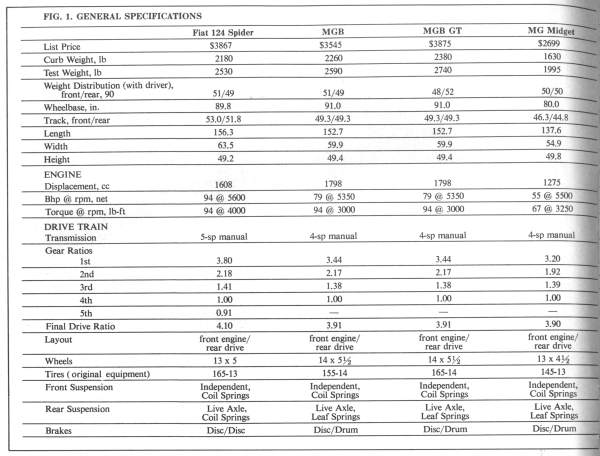
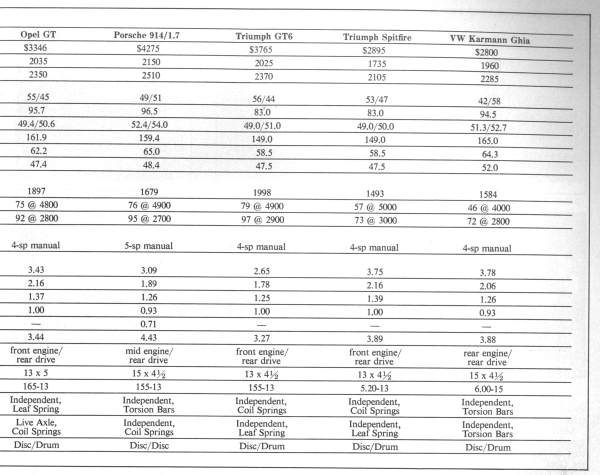
|
mostly, with a fast
sweeping turn leading into a decreasing-
radius right that exits into a banked left, down the hill into a sharp
right, a
left and another right, then uphill to the sweeper. All the elements,
then,
that a car would face on any track.
|
The Results BEFORE THE
race, though, let’s go back to the first of the
series of tests. In Fig. 2 are listed the results of the normal
times-to-speed
and distance tests.
|
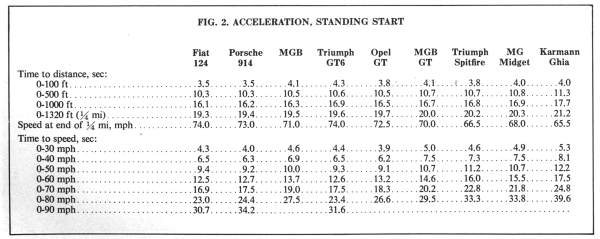
|
from rest is a function of
power-to-weight modified by
gearing: we have the Fiat, the most powerful car in the class, crossing
the
line first; then come the 914, the MGB, the GT6, the Opel, etc. The
GT6’s
relatively tall final drive gears put it behind the MGB despite the
MG’s
greater weight. The gap is not as wide as the spread in power-to-weight
would
lead one to expect, however. The Ghia has half the power of the Fiat
and is the
slowest of the nine, but even so it lags by only 2 sec at the finish.
On the
basis of a normal road test, we’d have to say that the difference in
performance is not extreme. But let’s move to the track. In Fig. 3 we
have the
times from turn 7A to the shut-off markers at the end of the straight.
There are three times for each car; |
the total from corner to marker, from the corner to the bridge, and from the bridge to the marker. Interestingly, the order has changed. The lightweight Opel has moved front fifth place at the drags to first past the marker. The GT6 is as close behind the Opel here as the Opel was behind the GT6 from a standing start. And the Fiat has moved back to third. Yet the power and weight hasn’t changed at all. But the use of gears and engine speeds for this test is different. The Opel has a tall final drive. Note that it’s especially quick from the corner to the bridge: it came through the corner at peak torque in second gear, with plenty of space left on the tachometer, and was peaking in third as it reached the shut-off marker. Thus it didn’t have to be dropped into a relatively dead top gear for the stretch. |
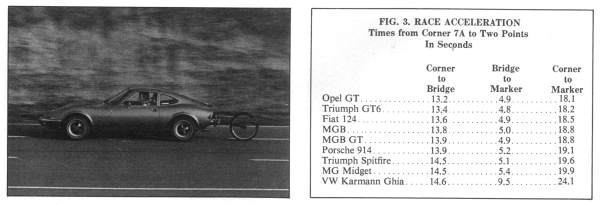
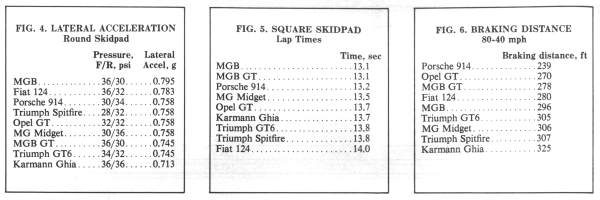
 Same for the GT6, except that its gearing is taller still, meaning that the 0T6 is still pulling strongly when it goes past the marker—so strongly that it nearly closes the gap on the Opel. This works both ways. The Fiat is wound tight in second at the corner and uses 3rd and 4th gears for this distance. The MOB only needs 2nd and 3rd but it can’t match the Fiat’s power, the MGB-GT is heavier still, and so on. The 914 particularly suffers here as it comes with an overdrive 5th for the open road and a very low first gear for city starts. From a standing start it gets a great leap forward and a good elapsed time for the quarter mile. But once into the upper gears, the lack of power and engine speed hurts it. And the Ghia Pure lack of power. For the first segment of this test it’s merely slow, lagging behind the others but not by much. At the bridge, though, the Ghia is shifted into top gear and acceleration becomes merely perceptible as the gap widens. What all this means is that if all nine cars came through turn 7A in a pack three wide and three deep, by the end of the straight they would no longer be a pack. They would be a string, with 6 sec between first and last. But, you may think here, what about cornering power? Surely these cars must vary in cornering power and this must influence the speed down the straight. Faster in, faster out, so to speak |
|


|
The results of
that are in Fig. 5. For once we don’t have a
new name at the top of the list: The MGB was best here, as it was going
around
the normal circle. But the MGB-GT tied with it. That’s a surprise, the
explanation for which is buried ‘way back in the specification table.
The
MGB-GT has more weight on the rear wheels, is in fact tail-heavy
whereas the
MGB has a forward weight bias. In this test, then, a car which can be
coaxed
into or naturally tends to oversteer does well. In a tight turn, the
understeering car must be forced around, front wheels scrubbing off
speed. The
oversteering or neutral car can be pointed, wagged and straightened
out. The
914 has gained on cars which it formerly only equaled. And look at the
Ghia—better
than both Triumphs and the Fiat! The latter car looked especially poor
in this
test. It understeers and rolls and does not do well in sharp changes of
direction, despite its good showing on the normal circle. 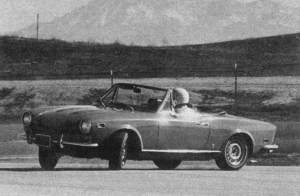 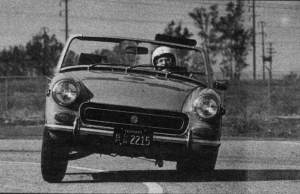 |
The Opel displayed a chronic problem:
in a tight
turn the
inside rear wheel lifts, the engine races, the tire spins and the car
just sits
there until the speed and the wheel both drop. The Opel didn’t come out
of the
turns fast, then, because it couldn’t power out. |

|
All they tell you
is which cars went around the Circuit
faster than which others, Why and how come from subjective assessments
from the
drivers, given in the order of increasing lap times. Triumph GT6—does everything well.
Plenty of power, gearing
that lets the power be used in these conditions and good brakes. The
car’s
natural understeer brings it around the fast sections under control,
and the
power lets the driver fling the car around the tight turns. Opel GT—has power, like the Opel
sedans that overwhelmed the
Showroom Stock class last year. And it corners and brakes fairly well.
What
hurt the Opel GT was the lifting inside wheel. The engine couldn’t be
used
fully until the car was pointed straight ahead and cruising through the
turns
in 3rd gear was as quick as sliding and spinning in 2nd. VW-Porsche 914—is listed first in a
tie with the MGB because
the fastest driver in the group said that if he just had enough time to
figure
out how the 914 would go best he could beat the MOB and the GT6 and
Opel. You
don’t get to the winner’s circle saying “if’ but if the handling had
been more
flexible or easier to learn, then maybe the 914 could have made up for
its lack
of power. The 914 was a bit of a disappointment. MGB—has more than
tradition
going for it. It feels harsh and clumsy but doesn’t look that way on
the
clocks. The MOB’s secret of success is that a driver can use everything
the car
has. Fiat 124—is perhaps the best of the boulevard racers. It has a
lovely
engine, a lot of power and soft suspension. It under- steers, but the
Fiat was
in fact the only car to spin during the test. We learned that the Fiat
went
best when driven gently around the fast corners and wound to redline on
the straights.
MGB-GT—take everything said about the MOB and add weight. The good
behavior
through tight turns is caused by the same heavy tail that makes the
coupe a
handful in the fast turns. Now we know why all the MOBs in production
racing
are convertibles. Spitfire—lap times aren’t everything.
The Spitfire is better
balanced than the GT6, and it’s more fun. |
Excellent throttle response,
so while the Car’s attitude
varies with power, the
power can be properly controlled. The Spitfire just lacks speed. It’s
deceptive,
for though the Fiat felt slower than it was, when our drivers climbed
out of
the Spitfire they went right to the timers expecting to have set a
record or
two. They didn’t, but they enjoyed trying. MG Midget—won nobody’s heart. The
lack of speed was expected
but the stiff and vague steering, the roll oversteer, the mushy front
end and
the general feeling of cramped obsolescence were things we had
forgotten. The
Midget won’t win races because it doesn’t go fast. Karmann Ghia—even slower than the
Midget, but at least more
fun. Or maybe it’s just the underdog aspect. Either way the Ghia has a
good
ride and proper steering, and it can be driven on the ragged edge
without
incident and with drama: what fun to watch it lift its inside front
wheel just
like a Porsche 9llS! The Ghia is out of contention here. It won’t win,
but
neither will it be disgraced. |
